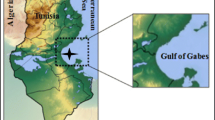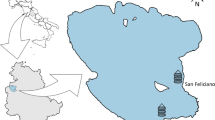Abstract
The present work details the analysis of heavy-metal and metalloid concentrations in exoskeleton, gill, hepatopancreas, and abdominal muscle tissues of 60 crayfish (Astacus leptodactylus) specimens collected from Lake Hirfanlı, a dam lake located in Kırşehir (Turkey) with a low metal-contamination profile. Concentrations of 11 metals (aluminum [Al], chromium [Cd], manganese [Mn], cobalt [Co], nickel [Ni], copper [Cu], molybdenum [Mo], silver [Ag], cadmium [Cd], mercury [Hg], and lead [Pb]) and a metalloid (arsenic [As]) were measured by inductively coupled plasma–mass spectrometry, and the relative frequencies of the most abundant isotopes of Cr, Cu, Ag, Cd, Hg, and Pb were evaluated. Three correlation trends were evaluated between the following: (1) different elements in the each individual tissue, (2) individual elements in different tissues, and (3) different elements in different tissues. In addition, correlation rates of growth parameters (weight, cephalothorax length, and total length) with heavy-metal and metalloid concentrations in each tissue were investigated. Our results suggest that substantial differences in metal and metalloid-accumulation levels exist between male and female specimens, with stronger correlations between the heavy-metal concentrations observed in the male cohort. It is notable that correlation trends of Co, Cu, 52As, Cr, and Ni in exoskeleton of the male specimens display strong similarities. Likewise, a very strong correlation is present in Ni–Cd and Ni–Pb accumulations in abdominal muscle of the male specimens; a similar trend is present between Cd and Pb concentrations in the same tissue of female specimens. For correlation rates of different heavy metals and metalloid in different tissues, the strongest positive association observed was between 63Cu in gill and As in hepatopancreas, whereas the strongest negative correlation was between accumulated Ni in abdominal muscle and As in exoskeleton. Strong correlations between metals and metalloid accumulations were observed between exoskeleton and gill. In many cases, metal and metalloid accumulation was negatively correlated with growth parameters. Preferential accumulation of Cr and Cu isotopes was observed in different tissues, suggesting that significant amounts of isotope fractionation occur during heavy-metal accumulation. Relatively low correlation rates were observed between 52Cr/53Cr and 63Cu/65Cu concentrations in several tissue types in both male and female cohorts, whereas no such trend was observed between Cd and Pb isotopes.

Similar content being viewed by others
References
Ahearn GA, Mandal PK, Mandal A (2004) Mechanisms of heavy-metal sequestration and detoxification in crustaceans: a review. J Comp Physiol B Biochem Syst Environ Physiol 174:439–452
Alcorlo P, Otero M, Crehuet M, Baltanás A, Montes C (2006) The use of the red swamp crayfish (Procambarus clarkii, Girard) as indicator of the bioavailability of heavy metals in environmental monitoring in the River Guadiamar (SW, Spain). Sci Total Environ 366(1):380–390
Alexopoulos E, McCrohan CR, Powell JJ, Jugdaohsingh R, White KN (2003) Bioavailability and toxicity of freshly neutralized aluminium to the freshwater crayfish Pacifastacus leniusculus. Arch Environ Contam Toxicol 45(4):509–514
Allinson G, Nishikawa M, De Silva SS, Laurenson LJ, De Silva K (2002) Observations on metal concentrations in tilapia (Oreochromis mossambicus) in reservoirs of south Sri Lanka. Ecotoxicol Environ Saf 51(3):197–202
Anderson M, Preslan J, Jolibois L, Bollinger J, George W (1997) Bioaccumulation of lead nitrate in red swamp crayfish (Procambarus clarkii). J Hazard Mater 54:15–29
Bankar AV, Kumar AR, Zinjarde SS (2009) Removal of chromium (VI) ions from aqueous solution by adsorption onto two marine isolates of Yarrowia lipolytica. J Hazard Mater 170:487–494
Bernhard M (1976) Manual of methods in aquatic environment research. Part 3: Sampling and analyses of biological material. Food and Agriculture Organization (FAO) Fish Technology Paper No. 158, UNEP, Rome, Italy
Bollinger JE, Bundy K, Anderson MB, Millet L, Preslan JE, Jolibois L et al (1997) Bioaccumulation of chromium in red swamp crayfish (Procambarus clarkii). J Hazard Mater 54:1–13
Cevik U, Damla N, Kobya AI, Bulut VN, Duran C, Dalgic G et al (2008) Assessment of metal element concentrations in mussel (M. galloprovincialis) in Eastern Black Sea, Turkey. J Hazard Mater 160(2–3):396–401
Farkas A, Salánki J, Specziár A (2003) Age- and size-specific patterns of heavy metals in the organs of freshwater fish Abramis brama L. populating a low-contaminated site. Water Res 37:959–964
Fatrorini D, Notti A, Regoli F (2006) Characterization of arsenic content in marine organisms from temperate, tropical, and polar environments. Chem Ecol 22(5):405–414
Gadzala-Kopciuch R, Berecka B, Bartoszewicz J, Buszewski B (2004) Some considerations about bioindicators in environmental monitoring. Pol J Environ Stud 13(5):453–462
Guner U (2007) Freshwater crayfish Astacus leptodactylus (Eschscholtz, 1823) accumulates and depurates copper. Environ Monit Assess 133(1–3):365–369
Gutierrez-Yurrita P, Sancho G, Bravo M, Baltanas A, Montes C (1998) Diet of the red swamp crayfish Procambarus clarkii in natural ecosystems of the Donana National Park temporary fresh-water marsh (Spain). J Crustacean Biol 18(1):120–127
Hothem RL, Bergen DR, Bauer ML, Crayon JJ, Meckstroth AM (2007) Mercury and trace elements in crayfish from Northern California. Bull Environ Contam Toxicol 79:628–632
Khan S, Nugegoda D (2003) Australian freshwater crayfish Cherax destructor accumulates and depurates nickel. Bull Environ Contam Toxicol 70(2):308–314
Kouba A, Buric M, Kozak P (2010) Bioaccumulation and effects of heavy metals in crayfish: a review. Water Air Soil Poll 211(1–4):5–16
Kurun A, Balkıs N, Erkan M, Balkıs H, Aksu A, Erşan MS (2010) Total metal levels in crayfish Astacus leptodactylus (Eschscholtz, 1823), and surface sediments in Lake Terkos, Turkey. Environ Monit Assess 169(1–4):385–395
Kwoczek M, Szefer P, Hac E, Grembecka M (2006) Essential and toxic elements in seafood available in Poland from different geographical regions. J Agric Food Chem 54(8):3015–3024
Lacerda LD, Santos JA, Lopes DV (2009) Fate of copper in intensive shrimp farms: bioaccumulation and deposition in pond sediments. Braz J Biol 69(3):851–858
Lopez FJS, Garcia MDG, Vidal JLM, Aguilera PA, Garrido Frenich A (2004) Assessment of metal contamination in Doñana National Park (Spain) using crayfish (Procamburus clarkii). Environ Monit Assess 93:17–29
Madigosky SR, Alvarez-Hernandez X, Glass J (1991) Lead, cadmium, and aluminum accumulation in the red swamp crayfish Procambarus clarkii G. collected from roadside drainage ditches in Louisiana. Arch Environ Contam Tox 20(2):253–258
Maher W, Goessler W, Kirby J, Raber G (1999) Arsenic concentrations and speciation in the tissues and blood of sea mullet (Mugil cephalus) from Lake Macquarie NSW, Australia. Mar Chem 68(1–2):169–182
Naghshbandi N, Zare S, Heidari R, Razzaghzadeh S (2007) Concentration of heavy metal in different tissues of Astacus leptodactylus from Aras Dam of Iran. Pakistan J Biol Sci 10(21):3956–3959
Nakayama SMM, Ikenaka Y, Muzandu K, Choongo K, Oroszlany B, Teraoka H et al (2010) Heavy metal accumulation in lake sediments, fish (Oreochromis niloticus and Serranochromis thumbergi), and crayfish (Cherax quadricarinatus) in Lake Itezhi-Tezhi and Lake Kariba, Zambia. Arch Environ Contam Toxicol 59(2):291–300
Norwood WP, Borgmann U, Dixon DG (2007) Interactive effects of metals in mixtures on bioaccumulation in the amphipod Hyalella azteca. Aquat Toxicol 84(2):255–267
Richert JC, Sneddon J (2008) Determination of heavy metals in crawfish (Procambrus clarkii) by inductively coupled plasma–optical emission spectrometry: a study over the season in southwest Louisiana. Anal Lett 41(17):3198–3209
Sikora E, Johnson T, Bullen T (2008) Microbial mass-dependent fractionation of chromium isotopes. Geochim Cosmochim Acta 72(15):3631–3641
Soedarini B, Klaver L, Roessink I, Widianarko B, Van Straalen NM, Van Gestel CA (2012) Copper kinetics and internal distribution in the marbled crayfish (Procambarus sp.). Chemosphere 87(4):333–338
Tunca E, Atasagun S, Saygi Y (2012) Yeniçağa Gölü’nde (Bolu-TÜRKİYE) Su, Sediment ve Kerevitteki (Astacus leptodactylus) Bazı Ağır Metallerin Birikimi Üzerine Bir Ön Çalışma. Ekoloji 21:68–76
Varmuza K, Filzmoser P (2009) Introduction to multivariate statistical analysis in chemometrics. CRC Press, Boca Raton, Florida
Ward R, McCrohan C, White K (2006) Influence of aqueous aluminium on the immune system of the freshwater crayfish Pacifasticus leniusculus. Aquat Toxicol 77(2):222–228
Weis J, Cristini A, Rao K (1992) Effects of pollutants on molting and regeneration in crustacea. Am Zool 32(3):495–500
Wigginton AJ, Birge WJ (2007) Toxicity of cadmium to six species in two genera of crayfish and the effect of cadmium on molting success. Environ Toxicol Chem 26(3):548–554
Yilmaz A, Yilmaz L (2007) Influences of sex and seasons on levels of heavy metals in tissues of green tiger shrimp (Penaeus semisulcatus de Hann, 1844). Food Chem 101(4):1664–1669
Acknowledgments
We thank Erdem Akıncı for expert guidance in carrying out ICP-MS measurements. This work is supported by the Turkish National Nanotechnology Research Center and Grants by the State Planning Organization of Turkey.
Author information
Authors and Affiliations
Corresponding author
Rights and permissions
About this article
Cite this article
Tunca, E., Ucuncu, E., Ozkan, A.D. et al. Tissue Distribution and Correlation Profiles of Heavy-Metal Accumulation in the Freshwater Crayfish Astacus leptodactylus . Arch Environ Contam Toxicol 64, 676–691 (2013). https://doi.org/10.1007/s00244-012-9863-3
Received:
Accepted:
Published:
Issue Date:
DOI: https://doi.org/10.1007/s00244-012-9863-3




